
Pseudohydnum gelatinosum, commonly known as the toothed jelly fungus, cat's tongue, or jelly tooth, is an Eurasian species of fungus in the order Auriculariales. Its common names refer to its gelatinous consistency and hydnoid (toothed) undersurface.
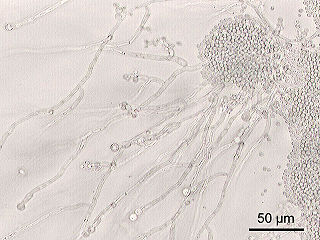
Saccharomycotina is a subdivision (subphylum) of the division (phylum) Ascomycota in the kingdom Fungi. It comprises most of the ascomycete yeasts. The members of Saccharomycotina reproduce by budding and they do not produce ascocarps.

The Ustilaginomycotina is a subdivision within the division Basidiomycota of the kingdom Fungi. It consists of the classes Ustilaginomycetes and Exobasidiomycetes, and in 2014 the subdivision was reclassified and the two additional classes Malasseziomycetes and Monilielliomycetes added. The name was first published by Doweld in 2001; Bauer and colleagues later published it in 2006 as an isonym. Ustilagomycotina and Agaricomycotina are considered to be sister groups, and they are in turn sister groups to the subdivision Pucciniomycotina.
Helicobasidium longisporum is a species of fungus in the subdivision Pucciniomycotina. Basidiocarps are corticioid (patch-forming) and are typically violet to purple. Microscopically they have auricularioid basidia. Helicobasidium longisporum is an opportunistic plant pathogen and is one of the causes of violet root rot of crops and other plants. DNA sequencing suggests that it is a complex of more than one species.

Geotrichosis is a mycosis caused by Geotrichum candidum.
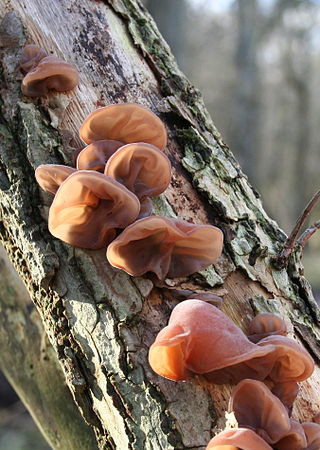
The Auriculariales are an order of fungi in the class Agaricomycetes. Species within the order were formerly referred to the "heterobasidiomycetes" or "jelly fungi", since many have gelatinous basidiocarps that produce spores on septate basidia. Around 200 species are known worldwide, placed in six or more families, though the status of these families is currently uncertain. All species in the Auriculariales are believed to be saprotrophic, most growing on dead wood. Fruit bodies of several Auricularia species are cultivated for food on a commercial scale, especially in China.

The Tremellales are an order of fungi in the class Tremellomycetes. The order contains both teleomorphic and anamorphic species, most of the latter being yeasts. All teleomorphic species in the Tremellales are parasites of other fungi, though the yeast states are widespread and not restricted to hosts. Basidiocarps, when produced, are gelatinous.

Sebacina is a genus of fungi in the family Sebacinaceae. Its species are mycorrhizal, forming a range of associations with trees and other plants. Basidiocarps are produced on soil and litter, sometimes partly encrusting stems of living plants. The fruit bodies are cartilaginous to rubbery-gelatinous and variously effused (corticioid) to coral-shaped (clavarioid). The genus has a cosmopolitan distribution.
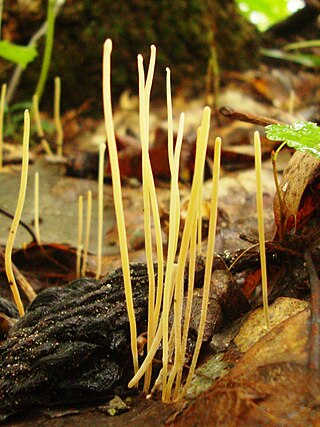
Macrotyphula is a genus of clavarioid fungi in the family Phyllotopsidaceae. Basidiocarps are simple, narrowly club-shaped to filiform, sometimes arising from a sclerotium. They typically grow on dead wood or leaf litter, often in swarms.
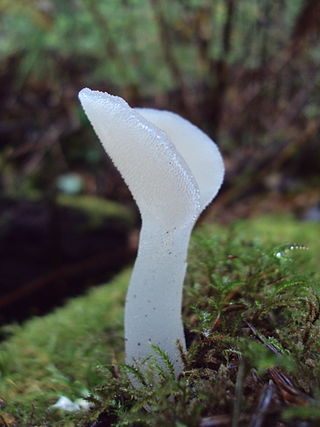
Pseudohydnum is a genus of fungi in the order Auriculariales. Basidiocarps are typically bracket-like and gelatinous, with or without a stipe, with a hydnoid (toothed) undersurface. The genus is widely distributed in both the northern and southern hemisphere, with thirteen species currently described and others awaiting description.

Ceratobasidium is a genus of fungi in the order Cantharellales. Basidiocarps are effused and the genus is sometimes grouped among the corticioid fungi, though species also retain features of the heterobasidiomycetes. Anamorphic forms were formerly referred to the genus Ceratorhiza, but this is now considered a synonym of Rhizoctonia. Ceratobasidium species, excluding the type, are also now considered synonymous with Rhizoctonia and some species have been transferred to the latter genus. Species are saprotrophic, but several are also facultative plant pathogens, causing a number of commercially important crop diseases. Some are also endomycorrhizal associates of orchids.

Rhizoctonia is a genus of fungi in the order Cantharellales. Species form thin, effused, corticioid basidiocarps, but are most frequently found in their sterile, anamorphic state. Rhizoctonia species are saprotrophic, but some are also facultative plant pathogens, causing commercially important crop diseases. Some are also endomycorrhizal associates of orchids. The genus name was formerly used to accommodate many superficially similar, but unrelated fungi.

The Ceratobasidiaceae are a family of fungi in the order Cantharellales. All species within the family have basidiocarps that are thin and effused. They have sometimes been included within the corticioid fungi or alternatively within the "heterobasidiomycetes". Species are saprotrophic, but some are also facultative plant pathogens or are associated with orchid mycorrhiza. Genera of economic importance include Ceratobasidium and Rhizoctonia, both of which contain plant pathogenic species causing diseases of commercial crops and turf grass.

Cerinomyces is a genus of fungi in the order Dacrymycetales. Species are saprotrophs and occur on dead wood. As originally conceived, the genus comprised species of the Dacrymycetes having effused, corticioid basidiocarps. Molecular research, based on cladistic analysis of DNA sequences, has however shown that this circumscription is not valid. As a result, the genus now contains some species having corticioid basidiocarps and some additional species with gelatinous, pustular basidiocarps. Around 30 species have been described worldwide.
Aspergillus brevipes is an anamorph species of fungus in the genus Aspergillus. It is from the Fumigati section. It was first described in 1952. It has been isolated from soil in Australia. Aspergillus brevipes produces roquefortine C, meleagrin and viriditoxin.
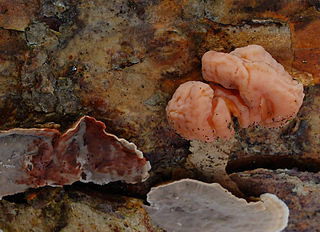
Naematelia encephala is a species of fungus producing pink, brain-like, gelatinous basidiocarps. It is widespread in north temperate regions and is parasitic on another species of fungus that grows on dead attached and recently fallen branches of conifers. In the UK, its recommended English name is conifer brain.
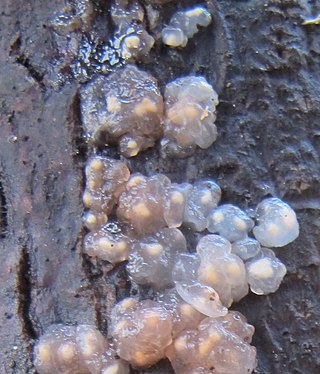
Myxarium is a genus of fungi in the family Hyaloriaceae. Basidiocarps are gelatinous and effused or pustular. The genus is cosmopolitan. All species grow on dead wood or dead herbaceous stems.

The Cerinomycetaceae are a family of fungi in the order Dacrymycetales. The family currently contains the single genus Cerinomyces which has a cosmopolitan distribution.

Hobsonia is a genus of fungi in the family Phleogenaceae. The genus is currently monotypic, with a single recognized species, Hobsonia mirabilis. The type species, H. gigaspora, and H. ackermannii are considered to be synonyms and additional lichenicolous species have now been transferred to the ascomycete genera Hobsoniopsis and Illosporiopsis. Hobsonia mirabilis is only known in its anamorph form, which is whitish, gelatinous, pustular, and occurs on dead woody plant remains. Microscopically, it produces coiled or spiralled conidia. The species was formerly of uncertain disposition, but molecular research, based on cladistic analysis of DNA sequences, has shown that it belongs within the Atractiellales. Though originally described from New York, the species is more commonly found in the tropics and subtropics.

Exidia saccharina is a species of fungus in the family Auriculariaceae. Basidiocarps are gelatinous, reddish brown, button-shaped at first then often coalescing and becoming irregularly effused. In the UK, it has the recommended English name of pine jelly. It grows on dead branches of conifers and is known from Europe, North America, and northern Asia.


















